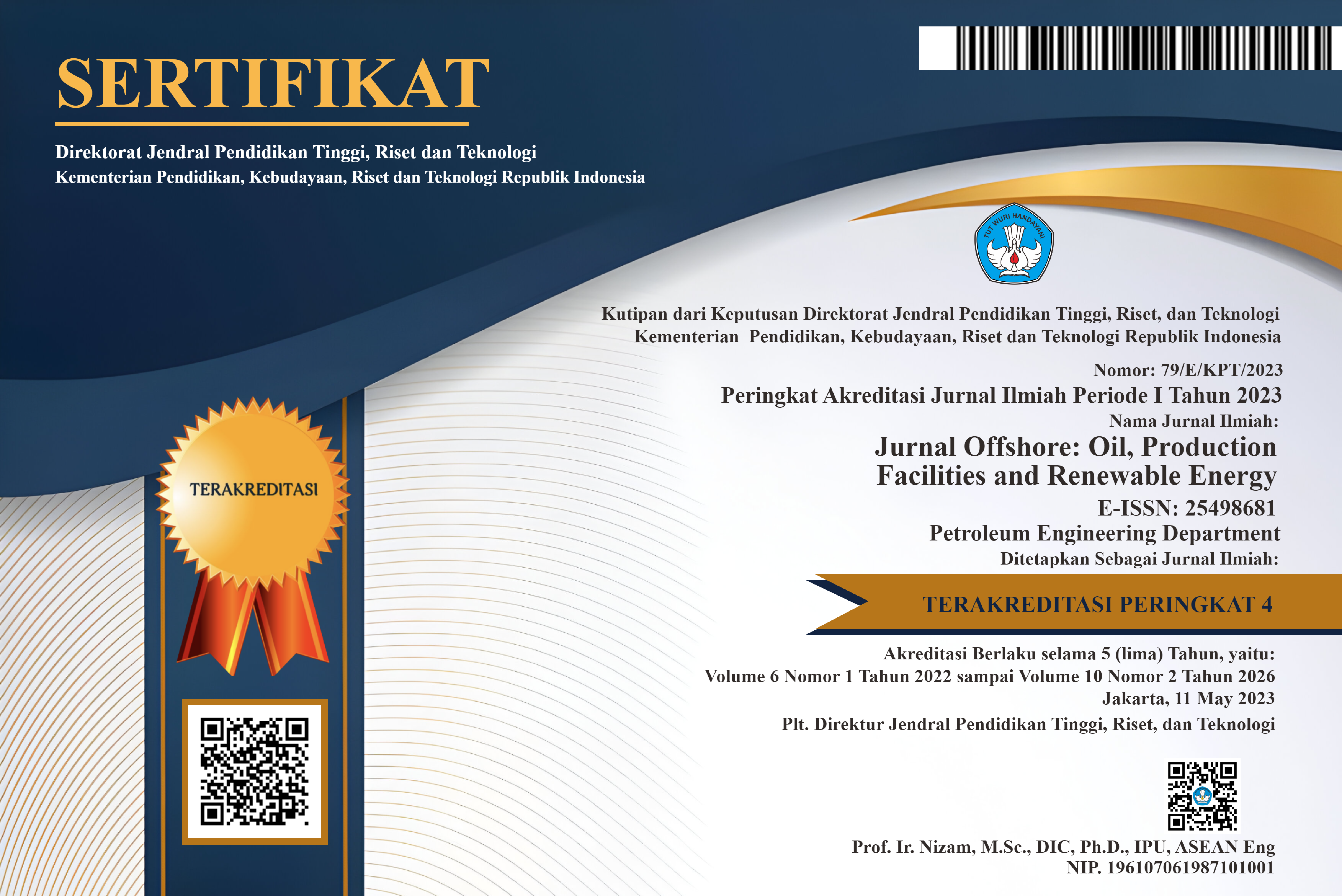Evaluasi Keberhasilan Penanggulangan Problem Scale Dalam Upaya Optimasi Produksi Pada Sumur “X” Lapangan “Y”
DOI:
https://doi.org/10.30588/jo.v6i2.1358Abstract
Abstrak
Pada Lapangan “Y” awalnya tingkat produksi pada sumur “X” tidak ada masalah atau dengan kata lain tingkat produksinya cenderung stabil. Sebelumnya yang awalnya tercatat tingkat produksi sumur “X” sebesar 97 bfpd dengan Water Cut 81% telah mengalami penurunan yang cukup signifikan pada Juni 2018 yaitu sebesar 42 bfpd dengan Water Cut 81.4%. Hal ini disebabkan oleh adanya Scale yang menyebabkan penurunan tingkat produksi tersebut. Sebelum dilakukan pengasaman sumur di uji dengan build up test menggunakan metode horner untuk mengetahui produktivitas sumur tersebut. Dari hasil uji tes sumur didapatkan data tekanan statik mula mula (P*), Tekanan 1 jam (P1 jam), Permeabilitas (K), Skin (S), produktivitas indeks (PI), dan Effisiensi Aliran (FE). Untuk menanggulangi terjadinya Scale maka dilakukanlah evaluasi untuk memilih metode yang efektif. Dalam pemilihan metode yang digunakan tergantung pada kondisi sumur. Setelah dilakukan evaluasi maka metode yang digunakan pada sumur ”X” adalah chemical methods yaitu dengan melakukan pengasaman (acidizing). Dari hasil Acidizing yang dilakukan laju produksi minyak sumur “X” mengalami kenaikan, dimana laju produksi yang sebelumnya yaitu sebesar 42 bfpd menjadi 166 bfpd. Analisis laju produksi menggunakan metode analisis Standing dan Vogel, untuk mendapatkan kurva IPR sebelum dan sesudah Acidizing dilakukan. Dengan terjadinya peningkatan laju produksi dan berkurangnya nilai skin (S) setelah kegiatan Acidizing, maka dapat dikatakan bahwa Scale yang terbentuk telah berhasil untuk diatasi.
Kata kunci: acidizing , scale, Skin
Abstrack
Field “Y” production level at well "X" had no problems, or in other words the production level tended to be stable. Previously, the production level of the well "X" was 97 bfpd with Water Cut 81%, which has decreased significantly in June 2018, namely 42 bfpd with Water Cut 81.4%. This is due to the Scale which causes a decrease in the level of production. Before the well acidification was carried out, it was tested with a build-up test using the horner method to determine the productivity of the well. From the well test results obtained data of initial static pressure (P *), 1 hour pressure (P1 hour), Permeability (K), Skin (S), productivity index (PI), and flow efficiency (FE). To overcome the occurrence of Scale, an evaluation is carried out to choose an effective method. In selecting the method used depends on the conditions of the well. After evaluating, the method used in the "X" well is chemical methods, namely by doing acidizing. From the results of Acidizing, the production rate of "X" well oil has increased, where the previous production rate of 42 bfpd became 166 bfpd. Production rate analysis used Standing and Vogel analysis methods, to obtain IPR curves before and after acidizing. With an increase in the production rate and a decrease in the skin (S) value after the Acidizing activity, it can be said that the Scale formed has been successfully treated.
Keywords: acidizing, scale, Skin.
References
Abrian, Yoga, dkk. 2015 Anaisis Kinerja Acidizing Pada PT Pertamina EP Asset 2 Pendopo Field. Palembang : Universitas Sriwijaya.
Allen, Thomas O, Roberts. 1982 Production Operation, 2 th ed. Tulsa, Oklahoma : Oil & Gas International Consultants, Inc.
Economides, Michael J, Nolte. 2000 Reservoir Stimulation, 3 th ed. USA : Wiley Publishing, 2000. Pp 15-20.
Patton,Charles C.1995. Applied Water Technology. Dallas,Texas : Campbell Petroleum Series.
Sari,Andini Perwita. 2005. Analisis Tingkat Keberhsilan Penanggulangan Scale CaCO3 dalam Upaya Optimasi Produksi Pada Sumur X Dengan menggunakan Kurva IPR. Palembang, Sumatra Selatan : Universitas Sriwijaya.
Downloads
Additional Files
Published
How to Cite
Issue
Section
License
Authors retain copyright and grant the Jurnal Offshore right of first publication with the work simultaneously licensed under a Creative Commons Attribution 4.0 International License that allows others to share (copy and redistribute the material in any medium or format) and adapt (remix, transform, and build upon the material) the work for any purpose, even commercially with an acknowledgement of the work's authorship and initial publication in Jurnal Offshore. Authors are able to enter into separate, additional contractual arrangements for the non-exclusive distribution of the journal's published version of the work (e.g., post it to an institutional repository or publish it in a book), with an acknowledgement of its initial publication in Jurnal Offshore. Authors are permitted and encouraged to post their work online (e.g., in institutional repositories or on their website) prior to and during the submission process, as it can lead to productive exchanges, as well as earlier and greater citation of published work (See The Effect of Open Access).















